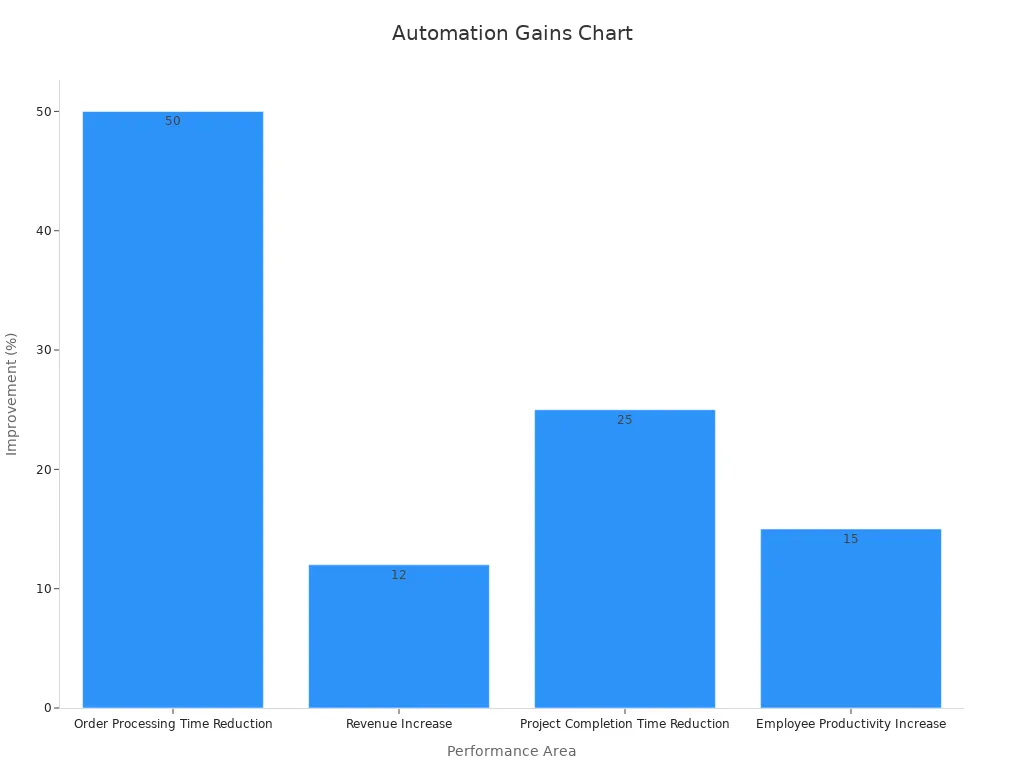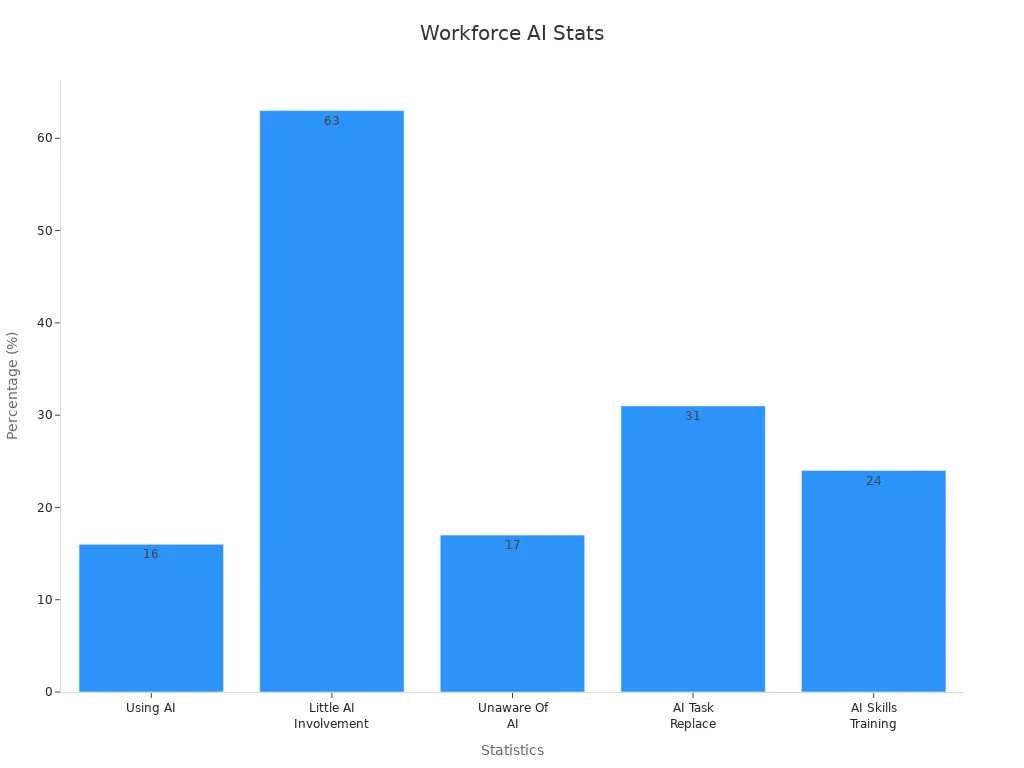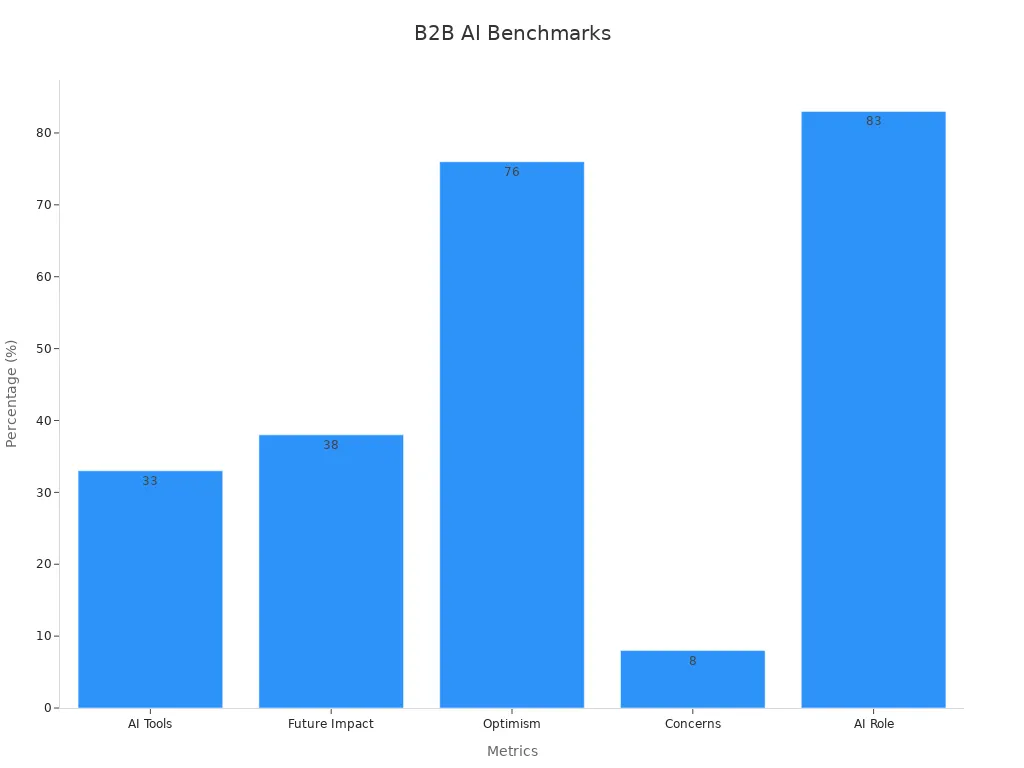The Impact of AI on B2B Growth

Artificial intelligence is changing how B2B businesses work, showcasing the significant impact of AI on their operations. It helps companies grow faster and smarter. AI can be used to customize marketing, study customer actions, and make better choices using data. For instance, 62% of companies already use AI to study data. Additionally, 86% of CEOs say personalization is key for customer campaigns, highlighting the impact of AI on enhancing customer engagement. AI can make work easier, cut costs, and make customers happier. About 79% of business leaders say AI is important for success, emphasizing the impact of AI on achieving business goals. Using AI wisely is now a must to stay ahead in today’s tough market.
Key Takeaways
AI helps companies grow by creating custom marketing plans using customer data.
Learning about customer habits with AI improves targeting and makes customers happier.
Predictive tools help businesses guess trends and plan for future needs.
AI handles boring tasks, saving time, cutting mistakes, and helping workers do more.
AI chatbots give quick help, making customers feel cared for and happy.
Adding AI to CRM tools helps rank leads and focus on important sales.
Teaching workers AI skills is key to getting the most from AI tools.
Using AI carefully keeps things fair and protects customer data, building trust.
The Impact of AI on B2B Growth
Personalization and Customer Insights
Hyper-personalized marketing with AI
AI helps create highly personalized marketing plans. It studies large amounts of customer data to find patterns. This lets you send messages that match what customers like. For example, AI can suggest products based on what someone has bought before. This method makes customers more interested and builds trust. A study shows how personalizing the B2B experience improves customer journeys. Tailored interactions help customers make decisions and feel more loyal.
Analyzing customer behavior for better targeting
Knowing how customers act is key to better marketing. AI tools check data from websites, social media, and shopping history. This helps find trends and guess what customers might do next. Companies using personalized strategies meet customer needs and stand out. AI gives deeper knowledge about customers. This helps create plans that match what they want.
Predictive Analytics for Smarter Decisions
Forecasting trends and customer needs
AI uses past data to predict future trends and needs. It finds patterns to help businesses prepare for what’s coming. For example, AI can guess which products will sell more in certain seasons. This helps companies plan better and stay ahead. Research shows predictive analytics boosts marketing and customer value.
Enhancing sales strategies with data-driven insights
AI improves sales by giving useful information. It helps focus on leads that are more likely to buy. The table below shows how predictive analytics helps B2B businesses:
Benefit | Description |
|---|---|
Better Sales Predictions | Uses past data to guess future sales, helping plan resources. |
Improved Lead Scoring | Finds which leads are most likely to become customers. |
Smarter Customer Grouping | Groups customers for better marketing, increasing satisfaction and loyalty. |
These insights help improve sales talks and get more customers.
Automation for Operational Efficiency
Streamlining repetitive tasks with AI
AI handles boring tasks so teams can focus on important work. Jobs like entering data, sending emails, and processing invoices can be automated. This saves time and reduces mistakes. For example, AI tools can process orders twice as fast. The table below shows how automation improves performance:
Improvement Area | Performance Figure |
|---|---|
Faster Order Processing | |
Higher Revenue | 12% |
Quicker Project Completion | 25% |
Better Employee Productivity | 15% |

Optimizing supply chain management
AI makes supply chains work better. It tracks inventory, predicts demand, and plans deliveries. This ensures products are in the right place at the right time. It reduces waste and makes things more efficient. AI helps businesses quickly adjust to changes and stay competitive.
Enhancing Customer Engagement
Real-time support with AI-powered chatbots
AI chatbots have changed how businesses help customers. They give quick answers to questions without delays. Chatbots can handle many questions at once. This makes it easier for businesses to help more people. It also cuts down waiting time and makes customers happier.
The table below shows how AI improves customer engagement:
Customer Engagement Metric | Improvement |
|---|---|
Enhanced Responsiveness | Quick answers make customers happier. |
Efficiency Improvements | Workers can focus on harder problems. |
Personalized Interactions | Special suggestions build trust and loyalty. |
Help is always available, day or night. | |
Data-Driven Insights | AI finds trends to improve service quality. |
Chatbots work all the time, so customers get help anytime. This builds trust and shows your business cares. Chatbots also use data to give answers that match what customers need. This makes chats feel more personal and helpful.
Personalizing communication to strengthen relationships
Talking to customers in a personal way is very important. AI helps create messages that match what people like. It studies customer data to find patterns and suggest ideas. For example, if someone buys a product often, AI can suggest items that go with it.
Here’s how AI makes communication better:
Quick replies make customers feel important.
Real-time data helps meet customer needs faster.
Special suggestions build loyalty and trust.
Faster problem-solving makes customers happier.
When you talk to customers in a personal way, they feel understood. This makes them want to come back. AI helps create these thoughtful experiences, even though it’s powered by technology.
AI-Powered Tools and Strategies

CRM Systems with AI Integration
Automating lead scoring and prioritization
AI in CRM tools makes lead scoring easier. It studies customer data and gives scores based on how likely they are to buy. This helps focus on important leads, saving time and working smarter. For example, HubSpot uses AI to find leads most likely to purchase. By focusing on these leads, sales teams can close deals faster and do better overall.
AI also improves the sales process by picking the best leads. Predictive tools find patterns in customer actions, helping teams spend time on the right people. This boosts conversion rates and makes sales plans stronger.
Improving customer relationship management with AI insights
AI changes how businesses manage customer relationships by giving helpful tips. For instance, Salesforce’s Einstein AI looks at customer data and suggests actions to take. These tips help connect with customers better, making them happier and more loyal.
AI tools also track customer activity across different platforms. This gives a clear picture of their journey. It helps create messages that fit their needs and gives a smooth experience. Using AI insights builds stronger bonds and trust with customers.
Chatbots and Virtual Assistants
Providing 24/7 customer support
AI chatbots make sure customers get help anytime they need it. They can handle many chats at once and answer questions quickly. This cuts down waiting time and makes customers happier.
Chatbots also make work easier by automating simple tasks. They answer FAQs and guide users through steps, letting teams focus on harder problems. This saves money on staff and increases productivity.
Reducing response times and improving satisfaction
Fast replies keep customers happy. AI chatbots give real-time help, so no question is missed. They also collect useful customer data during chats, helping improve marketing plans.
Chatbots give personal suggestions based on what users like. For example, they can suggest products that match someone’s interests. This makes customers feel special and keeps them coming back.
Content Creation and Marketing Automation
Generating AI-driven content for campaigns
AI tools make creating content faster and better. They study trends and customer likes to make material that connects with people. As Daryl Travis, Founder of Brandtrust, says, AI is changing how we create text, images, and videos.
With AI, you can make campaigns that grab attention and engage people. Predictive tools also find chances in the market, making sure your content fits customer needs. This helps your brand stand out and succeed.
Automating email and social media strategies
AI makes email and social media marketing easier by handling repetitive jobs. It sends custom emails based on what users do, like reminding them about items left in their carts. This increases sales and makes campaigns work better.
On social media, AI tools pick the best times to post and create fun content. They also automate LinkedIn tasks to find leads, saving time and boosting results. Using AI helps simplify marketing and get better outcomes with less effort.
AI in Sales Enablement
Finding the best leads with AI
AI helps find people most likely to become customers. It looks at data like past purchases and online actions. This helps focus on leads ready to buy, saving time.
For example, AI tools check how often someone visits your site. They also see how much they interact with your content. This helps you pick leads that match your sales goals. Your team can then close deals faster and do better overall.
AI also makes finding leads easier by doing boring tasks. It sorts through big lists and removes low-potential leads. This lets your team focus on better opportunities, boosting sales and saving time.
Making better sales pitches with AI
AI changes how you create and give sales pitches. It studies customer likes and past chats to give helpful tips. This helps you make pitches that fit each person better.
AI also shows which sales materials work best. For example, it tracks if product sheets or case studies help more. This helps you use the right tools to get better results.
The table below shows how AI improves sales:
Metric | What It Measures | How It Helps Sales |
|---|---|---|
Checks how well reps know products | Better knowledge leads to bigger deals | |
Training Scores | Tracks learning before and after training | Higher scores mean more deal growth |
Real-Time Skills Use | Measures how reps use skills during calls | Better skills lead to bigger deal sizes |
Content Usefulness | Tracks how well materials work | Speeds up sales with better tools |
Content Engagement | Measures how often content is used | Boosts conversions with helpful materials |
AI also helps during calls by giving real-time advice. It suggests answers to customer questions or concerns. This keeps your pitch strong and convincing, helping you close more deals.
AI speeds up training for new salespeople too. It gives quick access to lessons and performance tips. This helps new hires learn faster and do better.
With AI, every part of your sales process gets better. From finding leads to making great pitches, AI helps you grow and succeed.
Challenges and Considerations
Implementation and Integration Issues
Overcoming technical barriers to AI adoption
Using AI in business can be hard due to tech issues. Many companies find it tough to manage data, which AI needs to work well. Without good data, AI might give wrong results. A report shows that managing data properly is key for AI success. Setting up strong data rules helps AI work better and give correct insights.
Small businesses have shown it’s possible to beat these challenges. They adjust AI tools to fit their needs and see big improvements. For example, they start with small AI projects to save money and grow slowly. This shows even with fewer resources, AI can be added successfully.
Ensuring seamless integration with existing systems
Adding AI to old systems can be tricky. Old systems may not work well with new AI tools. To fix this, check your current setup and see what needs updating. A case study shows finding these problems early helps. You can then plan how to add AI without stopping your work.
Also, using AI tools that can grow with your business is smart. This way, your systems stay useful as your company grows. It also avoids future problems and makes AI more helpful over time.
Skills Gaps and Workforce Readiness
Addressing the need for AI expertise within teams
AI works best when your team knows how to use it. But many workers don’t have the skills needed for AI tools. Only 16% of workers use AI, while 63% know little about it. This shows the need for training programs to teach employees about AI.

Training your team in AI skills helps them feel confident. It also makes your business better at using AI tools effectively.
Upskilling employees to work alongside AI tools
Teaching your team new skills is important for using AI well. Hands-on training shows workers how to use AI in daily tasks. For example, sales teams can learn to use AI tools to find better leads and connect with customers.
Encouraging learning at work also sparks new ideas. When workers feel supported, they see AI as helpful, not as a threat to their jobs.
Ethical and Data Privacy Concerns
Ensuring ethical use of AI in decision-making
AI can help make decisions, but it can also cause problems. For example, AI might copy unfair patterns from the data it studies. This can lead to bad results in hiring or customer service. To stop this, set rules to make AI decisions fair and clear.
The European Union is making rules for fair AI use. The U.S. is slower, but businesses can still follow ethical practices. This shows your company cares about fairness and builds trust with others.
Protecting customer data and maintaining compliance
Keeping customer data safe is very important when using AI. Big data increases the chance of leaks or misuse. Follow rules like GDPR or CCPA to protect private information. Use strong security tools like encryption to keep data safe.
Teaching your team about data safety is also important. When everyone knows how to protect data, your business stays safe and trusted. This also helps avoid legal trouble and keeps customers happy.
Cost and ROI Considerations
Balancing AI investment with measurable returns
Spending money on AI can seem like a big deal. But knowing the benefits makes it easier to decide. Focus on results you can measure to see if it’s worth it. First, pick important goals for your business, like saving money or making customers happier. Then, track these goals over time to see progress.
AI gives both clear and hidden benefits. Clear benefits include fewer mistakes, faster work, and saving money. Hidden benefits, like better employee skills, also matter. For example, a hospital spent $950,000 on an AI tool for images. It cut reading time by 15% and improved accuracy by 10%. This saved $1.2 million each year.
Think about all costs when checking the value of AI. Costs include software, hardware, training, and getting data ready. Compare these costs to the benefits to understand the full picture.
Benefits | Description |
|---|---|
Fewer mistakes | AI reduces errors, saving time and money. |
Better skills | Workers learn new skills and feel motivated. |
Quick adjustments | AI helps businesses adapt to changes fast. |
Stay ahead | Using AI long-term keeps you ahead of others. |
Lower risks | AI gives accurate predictions to avoid problems. |
By comparing costs and benefits, you can decide if AI is worth it.
Avoiding over-reliance on AI without clear strategies
AI is helpful, but using it too much can cause issues. You need a plan to guide how you use it. Without a plan, AI might not work as expected. For instance, bad data can lead to wrong results, wasting time and money.
Don’t let AI replace human skills. Use it to help, not take over. While AI can handle tasks, people still need to make decisions. Workers should use AI tools to improve their work.
It’s also important to check costs versus benefits. Spend on AI where it helps most, like fixing mistakes or making customers happy. Set clear goals and check progress often to get the best results.
Tip: Let AI support your team, not replace them. This keeps technology useful and balanced.
When you mix AI with a good plan, you can grow your business while staying in control.
Future Trends in the Impact of AI on B2B Growth

Emerging AI Technologies
Generative AI changing content creation
Generative AI is changing how businesses make content. It uses smart programs to create text, pictures, and videos quickly. Tools like ChatGPT and DALL·E can make ads in minutes. This helps businesses create custom campaigns faster and easier.
A study shows 76% of marketers feel good about AI's future. Also, 83% think AI will help, not replace, human jobs. This shows AI and people can work together well.
Statistic | Insight |
|---|---|
AI tools usage | |
Future impact | 38% think AI will have the biggest impact. |
Optimism | 76% are positive about AI's role. |
Role of AI | 83% say AI will assist, not replace humans. |

Better communication with natural language processing (NLP)
NLP makes talking between businesses and customers easier. It helps tools understand questions and give clear answers. For example, AI chatbots now use NLP to sound more human when helping customers.
These tools also study feedback and social media comments. This helps businesses learn what customers like. Using NLP improves customer service and builds trust.
AI-Driven Personalization at Scale
Creating custom experiences on different platforms
AI helps businesses send personal messages on many platforms. It studies customer data to make emails, social posts, and website content fit each person. For example, Nike uses AI to suggest products, boosting online sales by 30%.
Company | Strategy Description | Result Description |
|---|---|---|
Nike | AI for personalized shopping experiences. | 30% increase in online sales. |
L’Oréal | AI-powered virtual beauty consultations. | 20% increase in sales, 25% better retention. |
Adobe | AI-driven marketing campaigns. | 15% higher engagement, 10% better conversions. |
These examples show how AI can improve loyalty and profits.
Guessing future customer needs with AI
AI helps predict what customers might want next. It looks at past actions and market trends to prepare for future demands. Businesses using AI for personalization are doing well in tough markets.
AI makes B2B customer experiences better.
It improves operations for steady growth.
It saves time by automating hard tasks.
AI in Predictive and Prescriptive Analytics
From reacting to planning ahead
Old business tools only explain past events. AI goes further by predicting and suggesting actions. This helps businesses plan ahead. For example, supply managers use AI to spot delivery problems early and fix them.
Aspect | Traditional BI | AI-Enhanced BI |
|---|---|---|
Focus | Looks at past data | Predicts and suggests actions |
Data Type | Uses simple data | Handles all kinds of data |
Decision-Making Type | Reacts to problems | Plans ahead to avoid issues |
Automation | Limited automation | Automates many tasks |
Adaptability | Fixed reports | Changes with new data |
This shift helps businesses avoid problems and find new chances.
Giving smart advice with AI insights
AI doesn’t just predict; it also gives helpful advice. For example, financial experts use AI to find market trends and suggest investments. These tips help businesses grow smarter.
Using AI for analytics helps you solve problems before they happen. It also helps shape your future plans, keeping you ahead in a changing world.
The Role of AI in Sustainability
Using AI to Save Resources
AI helps businesses use resources better and waste less. It looks at lots of data to give real-time tips on saving energy, water, and reducing waste. For example, AI can check how much energy or water you use and show where you’re wasting it. Fixing these problems saves money and helps the environment.
AI can also predict future needs. It shows how much energy you’ll need during busy times. This helps you plan and avoid wasting resources. Using AI this way makes sure resources are used smartly and sustainably.
Here are some examples of how AI helps save resources:
Siemens uses AI to track carbon emissions in its supply chain. It shows how changes, like using new suppliers, affect emissions.
A 2022 MIT Sloan study found AI helped businesses cut environmental issues by 45% when choosing suppliers.
AI also collects and reports environmental data automatically. This makes reports more accurate and saves time. By using AI, you can make smart choices that help your business and the planet.
Helping Green Projects with AI
AI helps businesses go green by making eco-friendly efforts easier. It automates carbon tracking, so you can measure and manage emissions better. For example, AI tools use data from sensors to give exact emission numbers. This solves problems with old methods that often guess emissions.
AI also helps businesses use renewable energy. It studies weather to improve solar and wind energy use. AI systems can also balance energy grids to make renewable energy work better.
Here’s how AI supports green projects:
It finds ways to recycle and cut waste.
It plans smarter delivery routes to save fuel and lower emissions.
It helps create eco-friendly products by studying materials and production.
Using AI for sustainability helps the planet and boosts your brand. Customers who care about the environment will like your efforts.
Tip: Start small by using AI to track energy use. As you see results, try more advanced tools.
AI has changed how B2B businesses grow by improving work and decisions. Klarna saved $6 million on image costs and cut project time from six weeks to seven days using smart AI tools. Also, 70% of marketing leaders now use AI, and 90% say it helps their work. But only 21% of business leaders fully use AI, showing the need for better planning. Solving problems and using AI wisely can help businesses grow and stay strong in a fast-changing market.
FAQ
What does AI do for B2B growth?
AI helps businesses grow by working smarter and faster. It makes tasks easier, personalizes customer experiences, and gives useful insights. AI also predicts trends and helps with better decisions. This lets you focus on big goals and get better results.
How can AI make customer engagement better?
AI tools like chatbots give quick help and personal replies. They study customer data to suggest things people like. This builds trust, makes relationships stronger, and shows customers they matter.
Is AI good for small businesses?
Yes, small businesses can use AI too. Many tools are affordable and easy to use. Start with simple ones like chatbots or CRM systems. These tools save time and improve customer service without costing a lot.
How does AI help in making decisions?
AI looks at data to predict trends and needs. It finds patterns in big data and gives helpful tips. This helps you make smarter choices based on facts.
What problems come with using AI?
Using AI can be hard because of tech issues and old systems. Teams may also need training to use it well. Start small, fix data problems, and teach your team to handle AI tools.
Will AI take over human jobs?
No, AI works with people, not against them. It handles boring tasks so workers can focus on creative work. Training your team helps them use AI better and feel confident.
How does AI keep data safe?
AI tools follow strict rules like GDPR to protect data. They use strong security like encryption to keep information private. Teaching your team about safety makes data even more secure.
Which industries gain the most from AI in B2B?
AI helps industries like healthcare, retail, and finance. It improves supply chains, marketing, and customer service. Any industry can use AI to work better and grow faster.
Tip: Begin with simple AI tools that solve your main problems. Add more as you see success.
See Also
Exploring Upcoming B2B Content Marketing Trends for 2024
Transforming Blogging: The Influence of AI Content Creators
Analyzing 2024 Blog Trends and Their Effects on Digital Marketing
Writesonic AI and QuickCreator: A Battle of Content Creators
Proven Blogging Techniques to Enhance Startup Growth and Visibility

